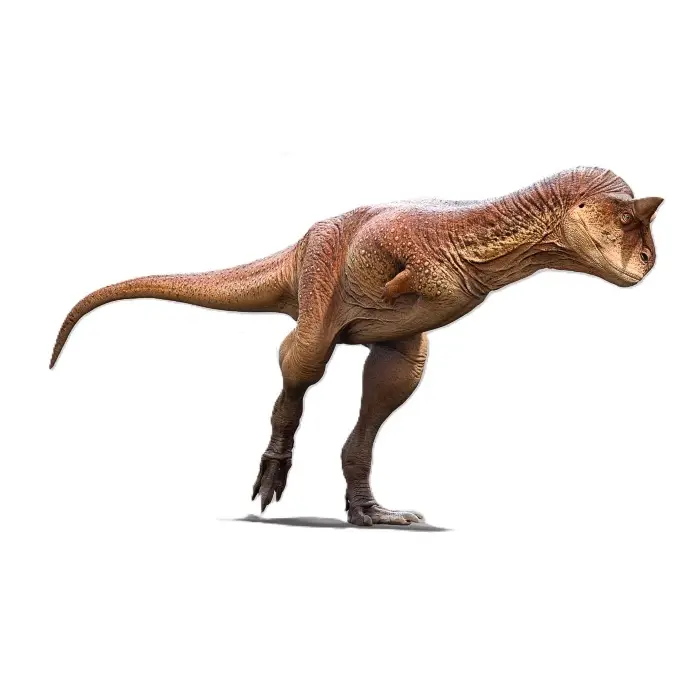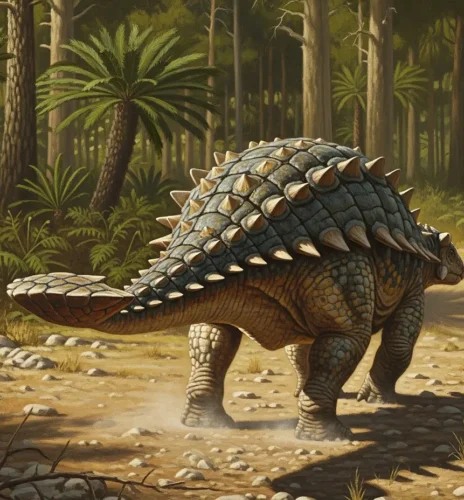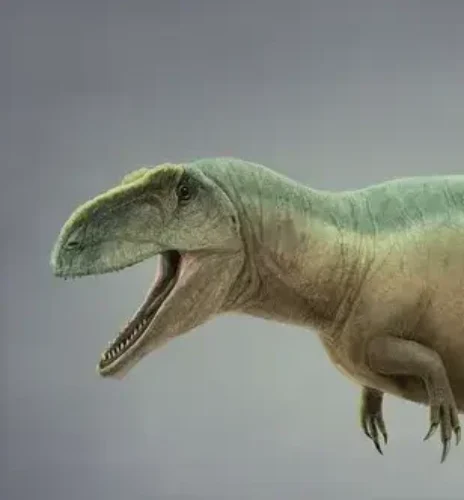While Tyrannosaurus rex and Velociraptor dominate the spotlight, the late Cretaceous period of South America was ruled by a different kind of predator: the Carnotaurus sastrei. With its distinctive bull-like horns and impossibly tiny arms, this dinosaur is a testament to the incredible diversity of theropods. The name itself, meaning “meat-eating bull,” captures its unique and aggressive appearance.
The single, remarkably complete specimen of Carnotaurus discovered in Argentina has provided an unparalleled look at a dinosaur group known as the abelisaurids. As we continue to study its unique anatomy, we are discovering that this creature was a highly specialized hunter, adapted for a specific role in its ancient ecosystem.
Here are five of the most fascinating facts about Carnotaurus:
1. The Bizarre Horns: More for Show than Battle? The most striking feature of Carnotaurus is the pair of thick, bony horns protruding above its eyes. While these were initially thought to be used for head-butting, similar to modern-day bulls, biomechanical studies suggest a different primary function. Research indicates that the skull was not built to withstand high-impact collisions. Instead, the horns were likely covered in a sheath of keratin, making them longer and sharper in life. Scientists now believe they were primarily for display, used in visual communication, species recognition, and to intimidate rivals or attract mates.
2. A Dinosaur with Skin Impressions: While we often have to guess about what dinosaurs looked like, a significant portion of Carnotaurus‘s fossilized skin was preserved. This is an incredibly rare find for a theropod. These impressions show that it had scaly, pebbly skin with rows of non-overlapping conical studs running down its body, and no evidence of feathers. This discovery provided a rare, tangible look at the texture and integument of a large carnivorous dinosaur, challenging the idea that all theropods were feathered.
3. The Fastest of the Giants: Despite its bulky appearance, Carnotaurus was a sprinter. Its long, slender hind limbs and a specialized tail structure point to incredible speed. A groundbreaking study in 2011 showed that its powerful tail housed a massive caudofemoralis muscle, which was crucial for pulling the legs backward and generating propulsive force. This made Carnotaurus a “speedster,” capable of bursts of speed estimated to be as high as 35 mph, making it one of the fastest large dinosaurs of its time.
4. The Smallest Arms of Any Large Theropod: Even compared to Tyrannosaurus rex, which is famous for its tiny arms, the forelimbs of Carnotaurus were astonishingly small and vestigial. They were so reduced that some paleontologists believe they may have been completely tucked within the animal’s body wall. These arms likely had no practical function in hunting or grasping and represent an extreme example of an evolutionary trade-off, where the power of the jaws and legs took precedence.
5. A Precision Predator: Carnotaurus had a relatively weak bite force compared to a T. rex, but its skull was adapted for a fast, “hatchet-like” biting motion. This suggests it was not a bone-crusher but a hunter that relied on quick, powerful bites to inflict slash wounds on its prey. Its large and well-developed olfactory bulbs also point to a keen sense of smell, suggesting it could track down prey from a distance. These adaptations, combined with its speed, paint a picture of a precision predator built for a specific type of chase and kill.
Recent Discoveries and Findings
- A New Sibling for Carnotaurus: In a major recent discovery, a new abelisaurid species named Koleken inakayali was found in the same rock formation as Carnotaurus in Argentina. Published in late 2024, this discovery is the first new abelisaurid from that region in nearly 40 years. Koleken was smaller and lacked the distinct horns of Carnotaurus, proving for the first time that multiple abelisaurid species coexisted in the same environment and highlighting the diversity of this unique dinosaur family.
- Biomechanics of the Bite: A recent biomechanical analysis of the Carnotaurus skull has provided new evidence that its cranium could withstand high-velocity impacts through its teeth. This further supports the “hatchet-like” biting hypothesis and provides quantitative data on the mechanics of its unique feeding strategy.
- The Role of the Horns: Recent studies have focused on the function of the horns, with a 2024 literature review concluding that their primary role was likely a display mechanism for species recognition and social signaling. While head-butting was possible, the evidence points more towards dominance displays and mating readiness, crucial for establishing a social hierarchy.
The story of Carnotaurus is a prime example of how paleontology is a dynamic science. New findings, from bone discoveries to biomechanical analysis, continue to challenge old ideas and bring us closer to understanding this unique and unforgettable predator from the southern continents.
Resources:
- Bonaparte, J. F., Novas, F. E., & Coria, R. A. (1990). Carnotaurus sastrei Bonaparte, the horned theropod from the Argentinean Upper Cretaceous. Contributions in Science, 416, 1-42.
- Méndez, A. H. (2012). The cervical vertebrae of the Late Cretaceous abelisaurid dinosaur Carnotaurus sastrei. Acta Palaeontologica Polonica, 59(3), 569-579. https://bioone.org/journals/acta-palaeontologica-polonica/volume-59/issue-3/app.2011.0129/The-Cervical-Vertebrae-of-the-Late-Cretaceous-Abelisaurid-Dinosaur-Carnotaurus/10.4202/app.2011.0129.full
- Hendrickx, C., & Bell, P. R. (2021). The skin of Carnotaurus sastrei (Theropoda: Abelisauridae) from the Upper Cretaceous of Patagonia, Argentina. Cretaceous Research, 125, 104884.
- Persons, W. S., & Currie, P. J. (2011). The caudal musculature of Tyrannosaurus rex and Carnotaurus sastrei. PLoS ONE, 6(11): e26744.
- Mazzetta, G. V. et al. (2009). Cranial mechanics and functional interpretation of the horned carnivorous dinosaur Carnotaurus sastrei. Journal of Vertebrate Paleontology, 29(4), 1361-1369.
- Thank you Jake Baardse (the artist)for this picture. This is the site we got the picture from https://www.une.edu.au/about-une/news-and-events/news/2021/09/scientists-reveal-the-fossilised-skin-of-a-bull-like-carnivorous-dinosaur



